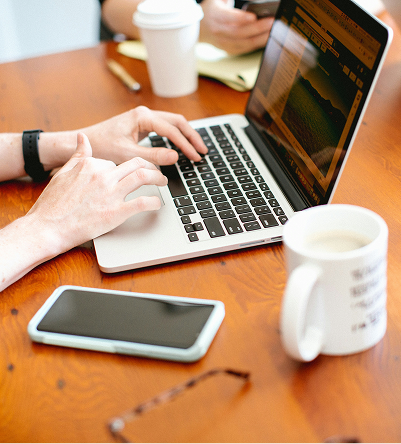
Govtech start-up: VISUALFY
We start the space of interviews to govtech startups with Visualfy, whose goal is to empower people with hearing difficulties, and the society they are part of, supporting with technology a real integration. Since 2017, this company has been revolutionizing the world of accessibility in public spaces with its innovative technology and unique algorithm in the world based on artificial intelligence, capable of recognizing sounds and translating them into visual alerts on any connected device. Visualfy's success lies, in addition to its technology, in the inclusion of deaf people in the development of its solutions so that they are always integrated in the generation of value.
We discussed the Gobe Insights initiative with Manel Alcaide, CEO & Co-Founder of Visualfy and he was happy to answer a few questions to explain in detail the function and impact of Visualfy.

Q: We believe there is a huge opportunity to innovate and improve the quality of life of people with disabilities. In addition to being an opportunity, it should be a priority, especially for the public sector. Tell us what specific problem Visualfy wants to solve.
A: Visualfy seeks to solve the following problems:
- The lack of acoustic accessibility in buildings and public spaces.
- The difficulties that hearing impaired workers have to integrate better, since there are acoustic and communication barriers.
- The inability of deaf people to hear alarms or alerts.
- The interruption of personal autonomy due to the mandatory use of protective masks in sanitary spaces.
Q: In fact, the Royal Legislative Decree 1/2013 was created to guarantee, among other things, the right to independent living for people with disabilities. However, its implementation seems to be still far from reality. What solutions does Visualfy suggest to the problems you have mentioned?
A: To solve the problem of acoustic accessibility of buildings (that any person, regardless of their hearing impairment, can access all public or private spaces and move independently or perform activities) Visualfy created a sound recognition algorithm based on artificial intelligence that converts them into light alerts distributed in the space or sends a notification to the user's personal device. Thanks to the lighting code and/or vibrations on the cell phone users can know if the fire alarm is ringing, if someone rings the doorbell or the phone for example.
On the other hand, to solve the problem of communication accessibility in spaces with a lot of noise pollution, Visualfy installs magnetic loops that work as microphones that capture the voice in real time, reducing outside noise, and send the sound directly to the receiver worn by the disabled person. As with speech recognition AI solutions to transcribe speech to text in real time.
Q: According to a study conducted by the University of Bristol in the United Kingdom, deaf people have a life expectancy 5 years less than hearing people. The main reason for this is the difficulty they have in accessing health information, which increases the possibility of not being diagnosed, being misdiagnosed or not following an adequate treatment. Could you give us a successful case in which Visualfy has solved this problem?
A: Visualfy integrated its mobile application with the facilities of the Hospital Universitario de Vinalopó (Alicante) and with its entire support system. Users must download this app a priori on their smart devices and receive text messages from the hospital that they can link to their smart watch or even set the light bulbs at home to alert them every 8h to take medication. Finally, with magnetic loops and voice-to-text transcription, communication problems with medical staff are solved.

Q: According to the INE, in Spain, there are more than one million people with recognized hearing impairment and it is estimated that 3 million more have some kind of hearing loss. However, this is a group that is often forgotten in accessibility projects. Why did Visualfy decide to start working with public administrations (PPAA)?
A: Despite the fact that the right to universal accessibility for people with disabilities is recognized in Spanish and European legislation, public authorities are often unaware of which initiatives and technologies are most appropriate in different contexts to improve the quality of life of people with hearing impairment, and budgets are invested in solutions that are not always the most appropriate.
On the other hand, the aging population and the excessively high volume of headphones or loudspeakers in discotheques, we are facing an increase in the population with deafness, so the problem also acquires magnitude. However, it is still a disability that is hardly detectable to the naked eye and the difficulties that these people have to lead an autonomous life are often ignored.
A: Manel, what advice would you give to institutions that want to try these new solutions?
Q: Public procurement of innovation should be encouraged and cooperation between public and private companies should be fostered in order to mutually benefit from each other.
In addition, to avoid falling into solutions that do not respond to the real problem and attack its causes, it is important to have the knowledge of specialized entities when designing policies or interventions to improve the acoustic accessibility of spaces and also in tenders and awards in public procurement of products or services that should solve the problem in question.
Visualfy is an international reference, and its team, formed by deaf and hearing people, is one of the great promoters of auditory accessibility for people with deafness. Thanks to Visualfy's work, people with hearing disabilities will have a better quality of life and access to information, supporting not only their personal autonomy but also impacting their health and life expectancy. If you want to know more about Visualfy's work as a virtual assistant for people with deafness, we recommend this article: López, M. (2019, March 25). Visualfy, la idea española que ofrece UN ASISTENTE virtual a las personas sordas.
References
Agencia Estatal Boletín Oficial del Estado. Ir a la página de inicio. (n.d.). Retrieved June 22, 2022, from https://www.boe.es/buscar/act.php?id=BOE-A-2013-12632&p=20220401&tn=1
López, M. (2019, March 25). Visualfy, la idea española que ofrece UN ASISTENTE virtual a las personas sordas. Xataka. Retrieved June 22, 2022, from https://www.xataka.com/otros-dispositivos/visualfy-idea-espanola-que-ofrece-asistente-virtual-a-personas-sordas#:~:text=Desarrollado por Marc Tamarit y,los habitantes puedan interpretarlas fácilmente
University of Bristol. (2015, January 30). Poor access to primary care results in poorer health for deaf people. 2015: Deaf health | Centre for Academic Primary Care | University of Bristol. Retrieved June 22, 2022, from http://www.bristol.ac.uk/primaryhealthcare/news/2015/deaf-health.html
Utilización de la Lengua de Signos por sexo y edad. Población de 6 y más años con discapacidad de audición. INE. (n.d.). Retrieved June 22, 2022, from https://www.ine.es/jaxi/Datos.htm?tpx=51628
Visualfy public admins ⋆ visualfy. Visualfy. (n.d.). Retrieved June 22, 2022, from https://www.visualfy.com/es/visualfy-public-admins/
World Health Organization. (n.d.). Sordera y Pérdida de la Audición. World Health Organization. Retrieved June 22, 2022, from https://www.who.int/es/news-room/fact-sheets/detail/deafness-and-hearing-loss







